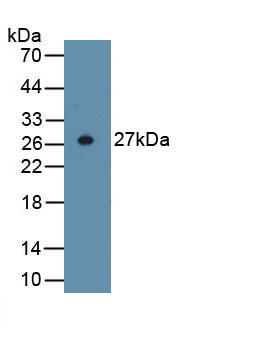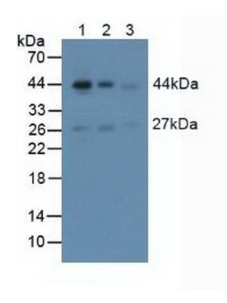Anti-Actin Alpha 2, Smooth Muscle (ACTa2) Polyclonal Antibody 

ACT-A2; ACTSA; ACTVS; Asma; GIG46; Cell growth-inhibiting gene 46 protein
Overview
Properties
- Product No.CAB342Mi01
- Organism SpeciesHomo sapiens (Human) Same name, Different species.
- ApplicationsWB
Research use only - DownloadInstruction Manual
- CategoryDevelopmental scienceBone metabolism
- PurificationAntigen-specific affinity chromatography followed by Protein A affinity chromatography
- LabelNone
- Buffer Formulation0.01M PBS, pH7.4, containing 0.05% Proclin-300, 50% glycerol.
- TraitsLiquid, Concentration 500µg/mL
Sign into your account
Share a new citation as an author
Upload your experimental result
Review

Contact us
Please fill in the blank.
Specifity
The antibody is a rabbit polyclonal antibody raised against ACTa2. It has been selected for its ability to recognize ACTa2 in immunohistochemical staining and western blotting.
Usage
Western blotting: 1:500-2000
Optimal working dilutions must be determined by end user.
Storage
Store at 4°C for frequent use. Stored at -20°C in a manual defrost freezer for two year without detectable loss of activity. Avoid repeated freeze-thaw cycles.
Stability
The thermal stability is described by the loss rate. The loss rate was determined by accelerated thermal degradation test, that is, incubate the protein at 37°C for 48h, and no obvious degradation and precipitation were observed. The loss rate is less than 5% within the expiration date under appropriate storage condition.
Organism Species More: Mus musculus (Mouse)Giveaways
Increment services
-
 Antibody Labeling Customized Service
Antibody Labeling Customized Service
-
 Protein A/G Purification Column
Protein A/G Purification Column
-
 Staining Solution for Cells and Tissue
Staining Solution for Cells and Tissue
-
 Positive Control for Antibody
Positive Control for Antibody
-
 Tissue/Sections Customized Service
Tissue/Sections Customized Service
-
 Phosphorylated Antibody Customized Service
Phosphorylated Antibody Customized Service
-
 Western Blot (WB) Experiment Service
Western Blot (WB) Experiment Service
-
 Immunohistochemistry (IHC) Experiment Service
Immunohistochemistry (IHC) Experiment Service
-
 Immunocytochemistry (ICC) Experiment Service
Immunocytochemistry (ICC) Experiment Service
-
 Flow Cytometry (FCM) Experiment Service
Flow Cytometry (FCM) Experiment Service
-
 Immunoprecipitation (IP) Experiment Service
Immunoprecipitation (IP) Experiment Service
-
 Immunofluorescence (IF) Experiment Service
Immunofluorescence (IF) Experiment Service
-
 Buffer
Buffer
-
 DAB Chromogen Kit
DAB Chromogen Kit
-
 SABC Kit
SABC Kit
-
 Long-arm Biotin Labeling Kit
Long-arm Biotin Labeling Kit
-
 Real Time PCR Experimental Service
Real Time PCR Experimental Service
Citations
- Toxoplasma gondii GRA15II effector-induced M1 cells ameliorate liver fibrosis in mice infected with Schistosomiasis japonicaPubmed:27157496
- Effects of repeated increasing doses of cisplatin as models of acute kidney injury and chronic kidney disease in ratsPubmed: 32936352
- Hesperidin inhibits the epithelial to mesenchymal transition induced by transforming growth factor-β1 in A549 cells through Smad signaling in the cytoplasm
- Structural Changes and Detection of Liver Fibrosis¨CRelated Protein Levels in Coculture of Alveolar Echinococcosis-Protoscoleces and Human Hepatic Stellate cells
- Structural changes and expression of hepatic fibrosis-related proteins in coculture of Echinococcus multilocularis protoscoleces and human hepatic stellate …34857049
- NOX5 mediates the crosstalk between tumor cells and cancer‐associated fibroblasts via regulating cytokine network34459125







